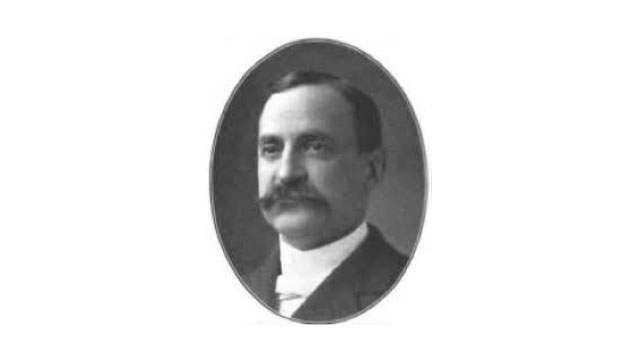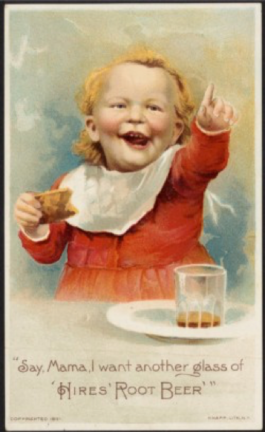
The story below was previously published in the Merion Friends Meeting June 2021 Newsletter. The article was written by Janet Frazer. We publish it here with thanks to Janet and Merion meeting.
Charles E. Hires was a pharmacist, an active member of Merion Meeting in the early twentieth century and an amateur historian.
Hires started his root beer business in the 1870s, at a time when beer or hard cider was the typical drink at mealtime and alcohol consumption was increasing rapidly (it expanded more than five times over the last 35 years of the nineteenth century). Taverns/saloons were important venues for social and political gatherings and there were more of these institutions than churches, schools, libraries, hospitals, parks and theaters combined. At about the same time that drinking was increasing, the temperance movement took off for the second time, often calling for equal rights for women as well as reduced alcohol consumption. Under its well-known president, Frances Willard, the WCTU sponsored parades, speeches and demonstrations. The end of the 19th century witnessed both more drinking and more protests against it.
Meanwhile, the temperance movement created an environment for alternative drinks and generated a market for them. By 1900 there were 2763 soft drink manufacturers in the United States producing birch beer, hop beer, ginger beer, spruce beer and colas. At first, Hires produced a tasty root tea, but soon changed its name to root beer, supposedly to appeal to miners. He offered free glasses of his concoction at the 1876 Centennial Exposition in Philadelphia and built a large plant on the Delaware River.

At first, the Women’s Christian Temperance Union declared root beer an alcoholic drink and called for a nationwide boycott of Hires Root Beer. In response, Hires mounted a vast advertising campaign. One Hires ad from 1895 reported that “3,134,393 packages of Hires Root beer were sold in 1894, which made 15,675,735 gallons, or 313,494,700 glasses, sufficient to give every man, woman and child in the United States five glasses.” In 1896, the WCTU called off its boycott.
By the early 20th century, soda fountains in the United States were serving up 65 million glasses of Hires Root Beer at a nickel each. Hires’ success was largely due to an audacious advertising campaign, possible only because of urbanization which enabled the development of advertising in large circulation newspapers, trading cards and national magazines. Hires claimed that not advertising was like winking at a girl in the dark: “You know you are doing it, but nobody else does”.
Although Hires’ first wife was a Quaker, Hires did not become a Friend until he married his second wife, Emily

Waln, who belonged to Merion Meeting. He has been described as a religious person: as a Baptist before he joined his wife’s meeting and then as a Quaker. He claimed integrity was part of the reason for his success. In a speech to the Friends Historical Association on the 300th anniversary of George Fox’s birth, Hires emphasized the divine obligation of Quakers to live “a pure and correct life”. Certainly he was himself very supportive of Friends’ organizations and principles; in 1918 he signed a letter from Philadelphia Yearly Meeting opposing WWI and he moved Friends Central to Lower Merion. His particular interest was in history and he wrote a booklet on the history of the Merion Meeting, paid for some repairs to the meetinghouse and financed a restoration of the meetinghouse grounds in 1915.
As a successful entrepreneur and self-made man, Hires is the best known member of Merion Meeting. His name still graces bottles and cans of Hires Root Beer.
Sources
- Groff, John M. “Charles E. Hires’ Rose Hill”. The First Three Hundred. Lower Merion Historical Society. http://lowermerionhistory.org/?page_id.
- http://lowermerionhistory.org/?page_id=187241
- Hingston, Sandy. 10 Things You Might Not Know About Root Beer Magnate Charles Hires.
- https://www.phillymag.com/news/2018/06/05/hires-root-beer-book/ Accessed March 6, 2021.
- Hiatt, Shon R., Wesley D. Sine, and Pamela S. Tolbert. “From Pabst to Pepsi: The Deinstitutionalization of Social
- Practices and the Creation of Entrepreneurial Opportunities.” Administrative Science Quarterly 54, no. 4
- (2009): 635-67. Accessed March 4, 2021. doi:10.2307/27749360.
- Hires, Charles E. “MERION MEETING.” Bulletin of Friends Historical Association 13, no. 2 (1924): 53-57.
- Accessed March 4, 2021. http://www.jstor.org/stable/41945353
- Hires, Charles E. A Short Historical Sketch of the Old Merion Meeting House Merion. Pa: self-published,1917.
- “THE SOCIETY OF FRIENDS AND THE WAR.” The Advocate of Peace (1894-1920) 80, no. 5 (1918): 145-47.
- Accessed March 5, 2021. http://www.jstor.org/stable/2066803